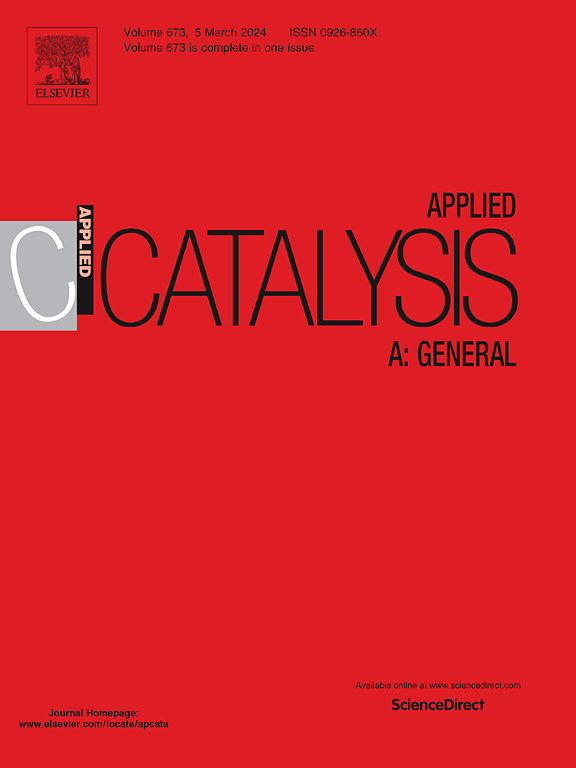Selective photo-oxidation of lignin-based alcohols to aldehydes catalyzed by gold nanoparticles supported on titanate nanotubes and nanowires
IF 4.8
2区 化学
Q2 CHEMISTRY, PHYSICAL
引用次数: 0
Abstract
Photocatalytic conversion of biomass and its derivatives is a promising strategy for producing energy and products of industrial interest. In this study, the selective photooxidation of lignin-derived alcohols (vanillyl and veratryl) to their respective aldehydes was investigated using gold nanoparticles (AuNPs) supported on hydrogen titanate nanotubes (HTNTs) and nanowires (HTNWs) under visible light and O2 at room temperature and pressure. The results show that the AuNPs/HTNTs and AuNPs/HTNWs systems are highly active and selective in the photooxidation of vanillyl and veratryl alcohol, with conversions above 90 % and selectivity above 95 % toward the formation of vanillin and veratraldehyde, respectively. The preparation of the photocatalytic systems by functionalization with (3-aminopropyl)trimethoxysilane and subsequent deposition–reduction with NaBH4 of Au in successive cycles allowed us to obtain metal loadings of 1, 3 %, and 5 % by mass, controlling the size, dispersion, and stability of the nanoparticles AuNPs. Physicochemical characterization of the solids showed that the incorporation of AuNPs into HTNT and HTNW supports led to an increase in oxygen vacancies, a decrease in the charge transfer resistance of the material, and thus a lower recombination rate of electron–hole pairs. Further studies in the presence of scavenger molecules and electron paramagnetic spectroscopy allowed us to conclude that under visible light, the AuNPs generate photoelectrons that move toward the conduction band of the support, where the reduction of O2 occurs to form the superoxide radical anion, the main reactive oxygen species causing the oxidation of alcohols.
钛酸盐纳米管和纳米线负载的金纳米颗粒催化木质素基醇选择性光氧化制醛
生物质及其衍生物的光催化转化是一种很有前途的生产能源和工业产品的策略。本研究以钛酸氢纳米管(HTNTs)和纳米线(HTNWs)为载体,在可见光和室温和常压下,研究了木质素衍生醇(香草基和戊基)选择性光氧化为各自的醛类。结果表明,AuNPs/HTNTs和AuNPs/HTNWs系统在香兰素和戊醛的光氧化反应中具有较高的活性和选择性,形成香兰素和戊醛的转化率分别在90% %以上,选择性在95% %以上。通过(3-氨基丙基)三甲氧基硅烷功能化制备光催化体系,随后用NaBH4沉积-还原金,在连续的循环中,我们获得了1、3 %和5 %的金属负载质量,控制了纳米AuNPs的大小、分散和稳定性。固体的物理化学表征表明,在HTNT和HTNW载体中掺入AuNPs导致氧空位增加,材料的电荷转移电阻降低,从而降低了电子-空穴对的复合速率。在清除剂分子和电子顺磁波谱存在下的进一步研究使我们得出结论,在可见光下,aunp产生光电子,这些光电子向载体的传导带移动,在那里O2发生还原形成超氧自由基阴离子,这是导致醇氧化的主要活性氧。
本文章由计算机程序翻译,如有差异,请以英文原文为准。
求助全文
约1分钟内获得全文
求助全文
来源期刊

Applied Catalysis A: General
化学-环境科学
CiteScore
9.00
自引率
5.50%
发文量
415
审稿时长
24 days
期刊介绍:
Applied Catalysis A: General publishes original papers on all aspects of catalysis of basic and practical interest to chemical scientists in both industrial and academic fields, with an emphasis onnew understanding of catalysts and catalytic reactions, new catalytic materials, new techniques, and new processes, especially those that have potential practical implications.
Papers that report results of a thorough study or optimization of systems or processes that are well understood, widely studied, or minor variations of known ones are discouraged. Authors should include statements in a separate section "Justification for Publication" of how the manuscript fits the scope of the journal in the cover letter to the editors. Submissions without such justification will be rejected without review.
 求助内容:
求助内容: 应助结果提醒方式:
应助结果提醒方式:


